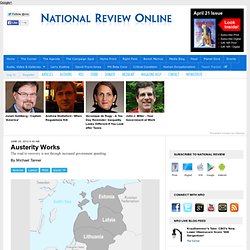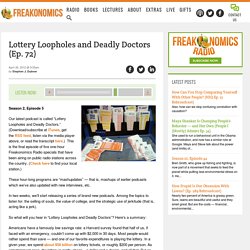

Replacing Obamacare: The Cato Institute on Health Care Reform. How Much Can Discrimination Explain? Mind blowing speech by Robert Welch in 1958 predicting Insiders plans to destroy America. Austerity Works - Michael Tanner. As Greece, and now Spain and Italy, struggle with the crushing burden of debt brought on by the modern welfare state, perhaps we should shift our gaze some 1,200 miles north to see how austerity can actually work.

Exhibit #1 is Estonia. This small Baltic nation recently had a spate of notoriety when its president, Toomas Ilves, got into a Twitter debate with Paul Krugman over the country’s austerity policies. Krugman sneered at Estonia as the “poster child for austerity defenders,” remarking of the nation’s recovery from recession, “this is what passes for economic triumph?”
In return, President Ilves criticized Krugman as “smug, overbearing, and patronizing.” Twitter-borne tit-for-tat aside, here are the facts: Estonia had been one of the showcases for free-market economic policies and had been growing steadily until the 2008 economic crisis burst a debt-fueled property bubble, shut off credit flows, and curbed export demand, plunging the country into a severe economic downturn. The Facts About Spending Cuts, the Debt, and the GDP - Reason. Editor's Note: Reason columnist and Mercatus Center economist Veronique de Rugy appears weekly on Bloomberg TV to separate economic fact from economic myth.

Raising the debt limit might put off a downgrade disaster in August, but that still isn’t enough—as Standard & Poor’s recent warning made clear. Perhaps the most important shot not heard around the world was S&P’s other admonition: Namely, that the U.S. bond rating will be downgraded in three months, if not sooner, unless we do something about government spending. Beyond raising the debt limit, S&P laid out clear criteria for avoiding a downgrade: 1) reduce the debt by about $4 trillion; 2) agree to a credible plan within three months; and 3) guarantee that this newfound fiscal discipline will actually stick. If S&P isn’t bluffing, then lawmakers should get serious about reducing the debt-to-GDP ratio, and they should do it quickly. But how do we achieve such a task? Take the work of Harvard’s Alberto Alesina and Silvia Ardagna. A Libertarian Gallop Through American History.
John Stossel - The Case for Private Roads. Blueseed: The Googleplex of the Sea. Policing is Too Important to be Left to the Government: Economist Ed Stringham. How a Local Blog Broke the Kelly Thomas Story: A conversation with Friends for Fullerton's Future. Tolls, Not Taxes: How Americans Want to Fix Traffic Jams. Lottery Loopholes and Deadly Doctors: A New Freakonomics Radio Podcast. Season 2, Episode 5 Our latest podcast is called “Lottery Loopholes and Deadly Doctors.”

(Download/subscribe at iTunes, get the RSS feed, listen via the media player above, or read the transcript here.) This is the final episode of five one-hour Freakonomics Radio specials that have been airing on public radio stations across the country. (Check here to find your local station.) These hour-long programs are “mashupdates” — that is, mashups of earlier podcasts which we’ve also updated with new interviews, etc. In two weeks, we’ll start releasing a series of brand new podcasts. So what will you hear in “Lottery Loopholes and Deadly Doctors”? Americans have a famously low savings rate: a Harvard survey found that half of us, if faced with an emergency, couldn’t come up with $2,000 in 30 days.
This episode looks at a little-known financial initiative that might help people save money while giving them the thrill of the lottery. Author D.J. Waldie on Being a 'Partisan of Suburban Places'